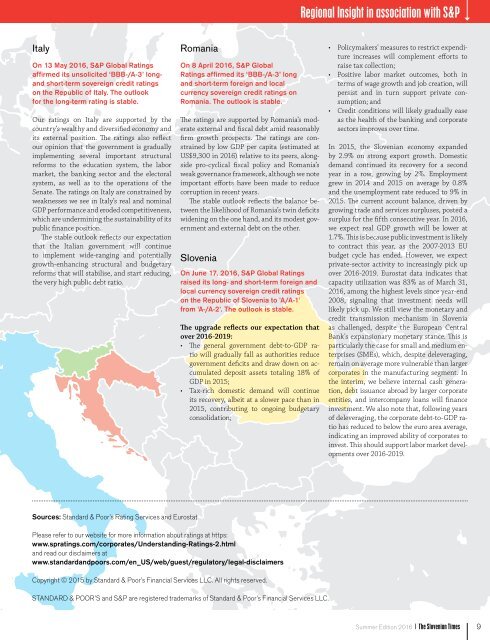Slovenia Times
You also want an ePaper? Increase the reach of your titles
YUMPU automatically turns print PDFs into web optimized ePapers that Google loves.
Regional Insight in association with S&P<br />
Italy<br />
On 13 May 2016, S&P Global Ratings<br />
affirmed its unsolicited ‘BBB-/A-3’ longand<br />
short-term sovereign credit ratings<br />
on the Republic of Italy. The outlook<br />
for the long-term rating is stable.<br />
Our ratings on Italy are supported by the<br />
country’s wealthy and diversified economy and<br />
its external position. The ratings also reflect<br />
our opinion that the government is gradually<br />
implementing several important structural<br />
reforms to the education system, the labor<br />
market, the banking sector and the electoral<br />
system, as well as to the operations of the<br />
Senate. The ratings on Italy are constrained by<br />
weaknesses we see in Italy’s real and nominal<br />
GDP performance and eroded competitiveness,<br />
which are undermining the sustainability of its<br />
public finance position.<br />
The stable outlook reflects our expectation<br />
that the Italian government will continue<br />
to implement wide-ranging and potentially<br />
growth-enhancing structural and budgetary<br />
reforms that will stabilise, and start reducing,<br />
the very high public debt ratio.<br />
Romania<br />
On 8 April 2016, S&P Global<br />
Ratings affirmed its ‘BBB-/A-3’ long<br />
and short-term foreign and local<br />
currency sovereign credit ratings on<br />
Romania. The outlook is stable.<br />
The ratings are supported by Romania’s moderate<br />
external and fiscal debt amid reasonably<br />
firm growth prospects. The ratings are constrained<br />
by low GDP per capita (estimated at<br />
US$9,300 in 2016) relative to its peers, alongside<br />
pro-cyclical fiscal policy and Romania’s<br />
weak governance framework, although we note<br />
important efforts have been made to reduce<br />
corruption in recent years.<br />
The stable outlook reflects the balance between<br />
the likelihood of Romania’s twin deficits<br />
widening on the one hand, and its modest government<br />
and external debt on the other.<br />
<strong>Slovenia</strong><br />
On June 17, 2016, S&P Global Ratings<br />
raised its long- and short-term foreign and<br />
local currency sovereign credit ratings<br />
on the Republic of <strong>Slovenia</strong> to 'A/A-1'<br />
from 'A-/A-2'. The outlook is stable.<br />
The upgrade reflects our expectation that<br />
over 2016-2019:<br />
• The general government debt-to-GDP ratio<br />
will gradually fall as authorities reduce<br />
government deficits and draw down on accumulated<br />
deposit assets totaling 18% of<br />
GDP in 2015;<br />
• Tax-rich domestic demand will continue<br />
its recovery, albeit at a slower pace than in<br />
2015, contributing to ongoing budgetary<br />
consolidation;<br />
• Policymakers' measures to restrict expenditure<br />
increases will complement efforts to<br />
raise tax collection;<br />
• Positive labor market outcomes, both in<br />
terms of wage growth and job creation, will<br />
persist and in turn support private consumption;<br />
and<br />
• Credit conditions will likely gradually ease<br />
as the health of the banking and corporate<br />
sectors improves over time.<br />
In 2015, the <strong>Slovenia</strong>n economy expanded<br />
by 2.9% on strong export growth. Domestic<br />
demand continued its recovery for a second<br />
year in a row, growing by 2%. Employment<br />
grew in 2014 and 2015 on average by 0.8%<br />
and the unemployment rate reduced to 9% in<br />
2015. The current account balance, driven by<br />
growing trade and services surpluses, posted a<br />
surplus for the fifth consecutive year. In 2016,<br />
we expect real GDP growth will be lower at<br />
1.7%. This is because public investment is likely<br />
to contract this year, as the 2007-2013 EU<br />
budget cycle has ended. However, we expect<br />
private-sector activity to increasingly pick up<br />
over 2016-2019. Eurostat data indicates that<br />
capacity utilization was 83% as of March 31,<br />
2016, among the highest levels since year-end<br />
2008, signaling that investment needs will<br />
likely pick up. We still view the monetary and<br />
credit transmission mechanism in <strong>Slovenia</strong><br />
as challenged, despite the European Central<br />
Bank's expansionary monetary stance. This is<br />
particularly the case for small and medium enterprises<br />
(SMEs), which, despite deleveraging,<br />
remain on average more vulnerable than larger<br />
corporates in the manufacturing segment. In<br />
the interim, we believe internal cash generation,<br />
debt issuance abroad by larger corporate<br />
entities, and intercompany loans will finance<br />
investment. We also note that, following years<br />
of deleveraging, the corporate debt-to-GDP ratio<br />
has reduced to below the euro area average,<br />
indicating an improved ability of corporates to<br />
invest. This should support labor market developments<br />
over 2016-2019.<br />
Sources: Standard & Poor’s Rating Services and Eurostat.<br />
Please refer to our website for more information about ratings at https:<br />
www.spratings.com/corporates/Understanding-Ratings-2.html<br />
and read our disclaimers at<br />
www.standardandpoors.com/en_US/web/guest/regulatory/legal-disclaimers<br />
Copyright © 2015 by Standard & Poor’s Financial Services LLC. All rights reserved.<br />
STANDARD & POOR’S and S&P are registered trademarks of Standard & Poor’s Financial Services LLC.<br />
Summer Edition 2016 | The <strong>Slovenia</strong>n <strong>Times</strong><br />
9


